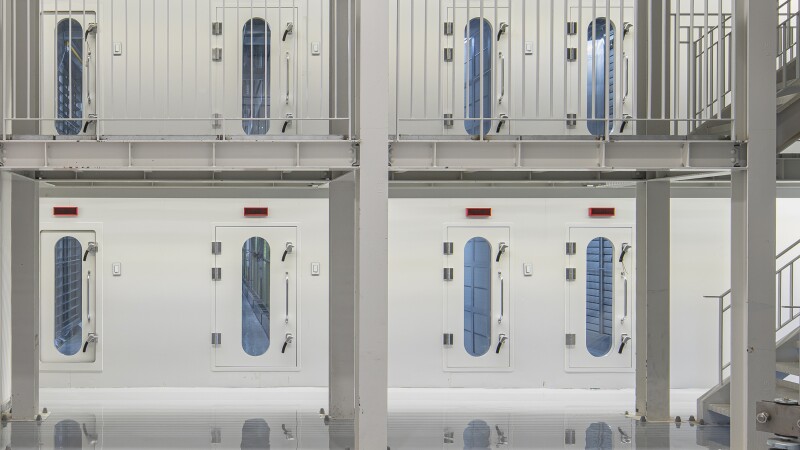In planning since at least 2019, the first phase of the site opened a year later than planned in November 2023. Covering nearly 300,000 square metres and with a potential 270MW capacity, this is the first of a planned three-stage opening. The whole facility is noteworthy both in its design and its operation – with robotics and inherent sustainability playing important roles.
GAK Sejong is a big facility for a big company. Naver may not be a household name globally compared to multinational hyperscalers, but it dominates the Korean market. Launched as an online platform in 1999, Naver was the first South Korean web portal to develop its own search engine. Known as the ‘Google of South Korea’, it in fact comprehensively outperforms its international rival in its home market, accounting for over 60% of all online search users, over double that of Google. As well as search, Naver hosts other data-hungry services, such as online video, e-books, TV streaming, and more, as well as four cloud regions across Asia.
While hyperscale data centres are a relatively recent entry to the Korean market, Naver started operating its own facility as far back as 2013, when the GAK Chuncheon data centre opened to service the company’s operations and data flows. Since then, traffic through the company’s platforms has continued to grow. With the advent of AI into the South Korean connectivity market, including a recently-launched LLM and AI platform, enormous scaling up of rack space has been required to meet the demand.
This is where the company’s GAK Sejong data centre comes in. By far the largest data centre facility in the country, it is designed with room for two further expansions in capacity to reach up to 270MW.
Sustainability through architecture

This is no box in an industrial park - the Connect One facility is a design attraction in its own right. It was designed by Japanese architectural heavyweight Kengo Kuma, whose previous projects include the Padova Congress Centre in Italy, the Rolex Tower in Dallas, and most notably the Japan National Stadium, which hosted the track and field events at the 2020 Tokyo Olympics.
“Our aim was to create an open and liberated space for learning and communications by integrating the building and the hills around it,” says the architect, and environmental harmony is certainly a feature of the finished design. Situated at the foot of a mountain, the facility was designed to use the cool, descending air as a natural coolant, ensuring sustainability is embedded into the data centre’s design.

“We have developed and applied a hybrid cooling system that utilizes up to 90 percent of external air,” said Roh Sang-min, head of Naver Cloud Data Centre, at a press conference at the site covered by the Korea Times. “We have configured the data centre to allow cold air to enter the server room quickly, reducing energy consumption." The configuration in question is a hybrid system, which the company called the NAVER Air Membrane Unit. Previously installed and refined at Naver's Chuncheon site, the system selects air sources to cool the equipment depending on real-time weather conditions.
Heat reuse is also built into the centre’s operation. Given the centre’s mountainous location, its excess heat is used to melt snow and ice on roads around and in the facility, as well as for floor heating inside the buildings. Rainwater is also collected at the facility and used for tending its landscaping and green areas. Thanks to these sustainability initiatives and heavy use of robotics onsite, the facility is committed to using 100% renweable energy by 2050 and 100% electric or hydrogen-powered vehicles by 2030.

Sejong, 150km out of Seoul, is a seismically active area, and this plays a role in the power supply decisions to the site. The main power supply line from the grid substation is duplicated to reduce the risk of outages, and redundant power line pairing is implemented for all internal power lines within the facility too. Given the earthquake risk, the facility is designed to withstand tremors of up to 9.0 on the Richter scale.
Robotic operations


Considering the size of the facility – a round trip between the operations building and the server room is nearly a kilometre – there is a strong focus on efficiency of operation. This is partially achieved by an impressive robotics operation. Naver Labs developed two autonomous robots for the Connect One site. One called GaRo moves up to 400kg of assets between server rooms, racks and operations centres. Another, SeRo, manages the actual racks and assets within the IT warehouses and server rooms, inserting and removing hardware with tolerances as precise as 2mm. A self-driving shuttle is also in operation across the site, moving employees from area to area in a more efficient fashion.
More will come from the Connect One site. The recently completed development is the first of a three-phase construction operation to deploy the full amount of planned processing power. But GAK Sejong’s first phase is an impressive start – with efficient engineering, sustainability built into the design from the start, pioneering internal operations, and a design that is respectful and complementary of the surrounding landscape.
The Datacloud series of events heads to Asia-Pacific in 2024 with the launch of the Datacloud APAC event on 6 and 7 May in Singapore - where you can discuss other upcoming data centre projects, build trends, and pressing matters in APAC digital infrastructure. More information can be found on this link.






